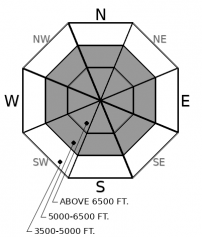| Sunday | Sunday Night | Monday | |
|---|---|---|---|
| Cloud Cover: | Mostly Cloudy | Mostly Clear | Partly Cloudy |
| Temperatures: | 21 to 28 deg. F. | 10 to 16 deg. F. | 20 to 26 deg. F. |
| Wind Direction: | Northeast | West | Southwest |
| Wind Speed: | 4G31 | 1G21 | 9G20 |
| Snowfall: | 1-3" in. | 0" in. | 0" in. |
| Snow Line: | 1500' | 1000' | 1000' |
Whitefish Range
Swan Range
How to read the forecast
An observer yesterday reported a booming collapse that radiated across the entire slope so dramatically that he had to change his underwear. To safely enjoy last night's foot of new snow without soiling your underwear - or worse - ride on slopes that are 30 degrees in steepness or less. Today, you can easily trigger slabs that break 1 to 2 feet deep and propagate surprisingly wide distances or drag you into rocks, logs, and stumps. Keep it conservative.

3. Considerable
?
Above 6500 ft.
3. Considerable
?
5000-6500 ft.
1. Low
?
3500-5000 ft.
- 1. Low
- 2. Moderate
- 3. Considerable
- 4. High
- 5. Extreme
-
Type ?
-
Aspect/Elevation ?

-
Likelihood ?CertainVery LikelyLikelyPossible
 Unlikely
Unlikely -
Size ?HistoricVery LargeLargeSmall

Up to a foot of new snow last night has tipped buried weak layers close to or beyond their breaking point. The snowfall from this past week has formed cohesive slabs 1 to 2 feet thick evenly distributed across the terrain above about 5,500' or 6,000' in elevation. However, these aren't your run-of-the-mill storm instabilities: they are failing on faceted crusts and surface hoar layers. This means you can trigger a slab avalanche that breaks above you or connects into adjacent terrain. Or you might not get glaring feedback until suddenly the whole slope collapses because of subtle differences in the slab or weak layer. Conservative terrain choices are the easiest way to manage this problem. Shooting cracks and collapses are your guardian angels steering you to lower angled slopes that aren't connected to steeper terrain above.
The storm came up a little short, and appears to be ending a little sooner, than we forecasted yesterday, so we aren't upgrading to an AVALANCHE WARNING today. Don't be fooled, the snowpack still took a gut punch last night and is now ripe for human triggering. As of 5 a.m., storm totals are 12" (2.0" SWE) in the Northern Whitefish Range, 10" (1.5" SWE) in Central GNP, 6" (.9" SWE) at Big Mountain, and 4" (.9" SWE) at Jewel Basin. Favored terrain likely saw a natural avalanche cycle last night that is now winding down as drier, cooler air moves over the region. Natural avalanche activity is possible in areas that receive more snowfall today.
While avalanches can certainly break within the new or windblown snow, we are emphasizing persistent slab travel management advice today. There are several tricky weak layers that were buried at the start of the month. One is a layer of surface hoar that we have found preserved between 5,500' and 7,000'. The other is a widespread facet crust layer. These are now your primary suspects that are most likely to be causing trouble today. A rider on Skook Face yesterday highlighted how unnerving these layers are by noting widespread collapses, one of which radiated across the whole slope (See observation). The amount of snow and weight on those weak layers doubled overnight. Your normal bag of tricks for handling new snow instabilities may not work today. Slabs could surprise you by propagating wider than expected or you might be able to trigger a slab remotely from low angle terrain.
Cooler air is filtering eastward through Marias Pass this morning, with valley temperatures dropping into the low 20's. Elsewhere, the freezing level remains near 6,000' under warm, moist, southwesterly flow. As the cold front advances across the region, we'll squeeze out a couple more inches of snow and winds will shift to the northeast. Dry conditions set up for tomorrow.
This forecast applies only to backcountry areas outside established ski area boundaries. The forecast describes general avalanche conditions and local variations always occur. This forecast expires at midnight on the posted day unless otherwise noted. The information in this forecast is provided by the USDA Forest Service who is solely responsible for its content.




















